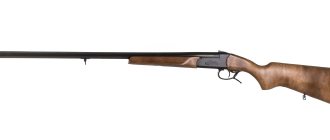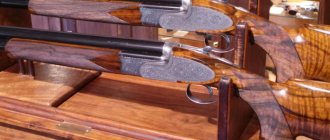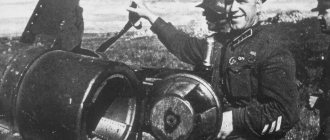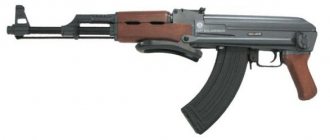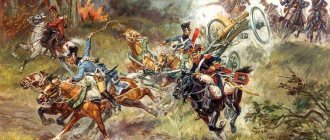We continue to introduce readers to the evolution of firearms from the beginning to the heyday
So, the first breakthrough in the history of weapons came with the invention of the wheel lock. For a long time it was believed that the first such lock was invented by the gunsmith Johann Kiefus from Nuremberg. However, later research revealed that the real creator of the mechanism is Leonardo da Vinci. An image of a wheeled castle is found in his drawings dating back to approximately 1483-1485.
Wheel lock
Operating principle
A design made of a metal disk and a cylindrical spring, which was locked with a special key. When the shooter pulled the trigger, he raised the lock, the released spring rotated the grooved wheel and it struck sparks from the flint in an amount sufficient to ignite the gunpowder on the lock shelf. This principle is still used in lighters today.
pros
The wheel lock was superior to both the matchlock and the later flint locks. It practically did not misfire; they only occurred when dirt got into the mechanism.
Minuses
Charging the weapon took quite a long time - after the charge was placed, it took time to wind the spring using the key. If a warrior lost the key in the field, the weapon became a very expensive club. In addition, combustion products very quickly contaminated the lock mechanism. The maximum number of shots from such a gun on the battlefield did not exceed 20. After this, the weapon had to be cleaned. The wheel mechanism was extremely expensive to produce; the lock alone could cost as much as a matchlock.
Weapons with a wheel lock mechanism were not widely used among infantry. Only cavalrymen and hunters appreciated its mobility. And since the latter, in addition to the combat characteristics of the gun, also paid attention to its appearance, artisans who knew how to perform the finest carvings, notches and engravings decorated the keyplate and other parts of the weapon with figures of people and animals - complex multi-figure compositions on mythological themes. Naturally, such a weapon was much more expensive than a regular one - after all, each gun turned into a real work of art.
Description of the flint pistol D7/1305 (2 barrels, France, 18th century)
An elegant weight and size modification from the famous Spanish company Denix is an exact copy of a French flint pistol of the 18th century. The model is distinguished not only by its ideal design, but also by the ability to simulate a shot.
The silicon pistol D7/1305 (2 barrels, France, 18th century) is manufactured using high-strength and proven materials. One of these materials is a metal alloy.
Metal is used to make a weapon barrel, trigger, flint over the powder flange, trigger and guard. A special solution is used to protect metal elements from corrosion.
Another irreplaceable material is considered to be an impact-resistant polymer, which looks like ivory. An exquisite pattern is depicted on the surface of such a polymer.
The body length is 300 mm, and the total weight of the structure does not exceed 900 grams. And at the same time, the price of the MMG silicon pistol D7/1035 will pleasantly surprise even the most picky buyer.
The firearm version of the pistol originally appeared in the early 18th century in France. A distinctive feature can rightfully be considered the presence of two barrels at once.
Thanks to this, the shooter could make a more powerful shot and hit the enemy in close combat. After this, you will need to reload the weapon, which takes quite a lot of time.
However, during a fierce battle it will not be possible to quickly reload, and to protect against enemy attacks, a rather impressive knob in the shape of an eagle’s head is provided on the underside of the pistol.
You can buy a flintlock pistol D7/1305 (2 barrels, 18th century France) not only in our retail store, but also on the official website with delivery to remote cities in the Russian Federation.
The presented model is undoubtedly suitable for use as the main prop on theater stages and feature film sets. The model will also be an ideal gift for both collectors and lovers of antique weapons.
Flintlock
The complex system and high price of the wheel lock, as well as the improvement of the ignition system for the combat charge, forced designers to look for a more acceptable solution. Such a solution was soon found: the flintlock appeared in the middle of the 16th century. Historians do not have one theory about the authorship of this mechanism, although, most likely, it was invented at the same time in several countries. Proof of this is the presence of territorial varieties: Swedish, Dutch, Baltic, Spanish, Mediterranean, Russian, Karelian and other types with different arrangements of parts and components, and principles of interaction of individual parts.
The flintlock was used until the advent of unitary-type capsules and cartridges. And even after that, some hunters, even until the first half of the twentieth century, preferred to use it, because shooting was very cheap: only gunpowder and bullets were needed.
Operating principle
In a flintlock, the ignition of gunpowder occurs from a spark produced by a spring-loaded hammer in which a piece of flint is clamped. The flint produces a spark when it hits the corrugated steel cover of the powder shelf (flint), simultaneously opening it. A spark ignites a small amount of gunpowder placed on the shelf, and through a special seed hole in the barrel the flame reaches the main powder charge.
All this made it possible to get rid of the capricious smoldering wick and construct a much simpler lock compared to a wheel lock. The combination of these qualities allowed the military ministries of European countries to equip most of the military units of their armies with such weapons.
Like any innovation, the flintlock was initially received with distrust. For example, the French monarch Louis XIV issued a decree banning the use of flintlocks in the army. Violators were punished by death. Infantrymen continued to arm themselves with matchlock weapons, while cavalry units preferred the wheel lock. To mitigate the situation, some gunsmiths created combined-action flint-wick locks. Changes and improvements were constantly made to the design of the flintlock, which made this type of weapon quite reliable.
pros
In a flint lock, it was not necessary to wind the mechanism with a key, as in a wheel lock; it was more technologically advanced, simpler, and therefore not so expensive. Thanks to the ease of loading the gun, the shooter could fire 2-3 shots per minute or more. In particular, the famous Prussian infantry of the 17th century was famous for firing about 5 rounds per minute. And a 33-gram bullet, which was used in 18th-century guns equipped with 11 grams of black powder, pierced a dozen cuirasses (metal breastplates) from a distance of 43 m and left significant dents on five more.
Minuses
The flint lock frequently misfired, which required the shooter to constantly pay attention and care for the mechanism. With a working lock, the number of misfires was approximately 15% of all shots. Usually the cause of a misfire lay in worn-out or poorly secured flint, worn-out flint, or a pilot hole clogged with soot. The seed powder on the shelf, despite the protection of the spring-loaded lid, became damp over time and became unsuitable for firing. Because of this, it was impossible to keep the gun loaded for a long time; the gunpowder on the shelf had to be changed quite often. When fired, a dense cloud of powder smoke appeared above the shelf, temporarily blocking the shooter’s view. Accuracy also left much to be desired - an average shooter at a distance of 100 steps hit the target only half the time. Misfires were common. The best Austrian guns fired them on every 62nd shot, those made in Russia - on the 22nd, French - on the 15th.
Repeating shotguns
Masters pondered the issue of increasing the rate of fire back in the 15th century. Since at that time there were no mechanisms that would facilitate and speed up reloading, it was necessary to take not by quality, but by quantity. At the beginning of the 15th century, multi-barreled guns appeared, which had up to 7 barrels. The original 8-barrel gun dating from 1597 has survived.
After the mid-16th century, rifled guns with wheel locks began to be produced in Germany. The trunks in them were located vertically. They were quite heavy and clumsy, so hunters preferred lighter, single-barreled ones. On raids and flights, where they had to shoot often, hunters took with them several single-barreled shotguns. With the invention of the flintlock, the situation did not change radically.
In 1654, for a passionate fan of hunting, Tsar Alexei Mikhailovich, Russian gunsmiths Kuzovlev and Boltyrev designed a double-barreled shotgun with vertically positioned barrels and flintlock-type locks. It was in this century that guns with interchangeable barrels first appeared: two rifled barrels were intended for firing bullets, two smooth ones for shot.
Double-barreled shotguns gained popularity among hunters only after the French master Leclerc created a lightweight hunting double-barreled shotgun with horizontal barrels in 1738. Such guns became widespread in the 19th century.
Weapon Bastards
The idea of increasing the rate of fire of weapons led to the fact that in the process of improvement, the creators invented peculiar “freaks”.
In the first half of the 17th century, guns with a long barrel and ignition holes located along it appeared. It was necessary to bring the wick to the holes or move the wheel lock towards the butt. After each action a shot sounded, sometimes it happened that instead of one charge, two exploded. This, at best, led to damage to the gun. Therefore, it was necessary to carefully measure the powder charges and very carefully separate them with wads.
Craftsmen in the Russian Empire became the authors of many “inverted guns”. Gunsmith Pervusha Isaev at the beginning of the 17th century invented the following design - by placing powder charges and bullets in a drum that rotated, he created the prototype of a breech-loading revolver-type gun.
The Dutch master Caspar Kalthof decided to use the stock as a magazine. He placed two pipes in it. The top one contained 15 bullets and the bottom one contained gunpowder. Before shooting, it was necessary to move the trigger guard to the right and forward to feed gunpowder and bullets into the breech, while the hammer was automatically cocked and a portion of seed powder was poured out. This system was quite dangerous. If the shooter did not close the brace well enough, the stock could explode.
Characteristics of the MMG flint pistol D7/1305 (France 18th century, 2 barrels)
| Type | MMG |
| Manufacturer | Denix |
| Combat prototype | Flintlock pistol France 18th century |
| Possibility of disassembly/assembly | No |
| Size | Length - 300 mm |
| Weight | 900 grams |
| Housing material | Metal alloy |
| Handle material | Plastic |
| Color | Gold |
| Peculiarities | Shot simulation |
| Country of Origin | Spain |
| Equipment | Pistol mockup, instructions, packaging |
Flintlock pistol D7/1305 (with 2 barrels, France, 18th century) buy in the Popadiv10 online store. Flintlock pistol D7/1305 (with 2 barrels, France, 18th century) at a low price of 3,490 rubles. You can pay for your order by mail upon receipt in any part of the Russian Federation. Before placing an order, be sure to check the price and contents of the product by phone (during business hours) or by e-mail and feedback system (at any time convenient for you).
Information on the product “Flintlock pistol D7/1305 (with 2 barrels, France of the 18th century)” is for informational purposes only and is not a public offer determined by the provisions of Article 437 of the Civil Code of the Russian Federation; characteristics, appearance, color and equipment can be changed by the manufacturer without notice.


